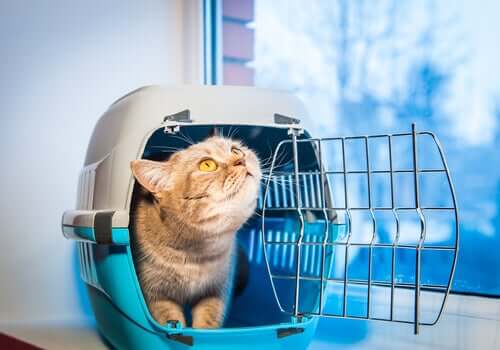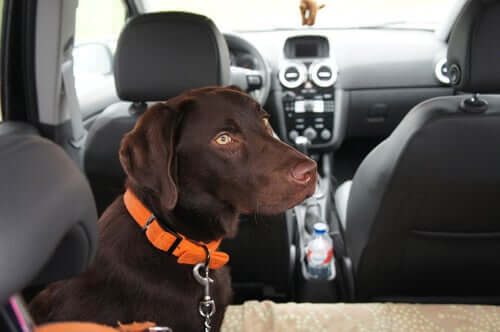Precautions to Take When Traveling with Pets by Car

It’s never a good feeling to leave your pet at home while you go traveling or on vacation. That’s why sometimes it’s better to take your pet with you. If you decide to travel by car with your pet, there are a couple of precautions you should take to ensure you can all travel comfortably. So, what should you consider when traveling with pets?
In addition to the relevant precautions, it’s also worth bearing in mind that there are laws that regulate the transport of pets in private vehicles.
How to transport your pet
According to law, there are several items that can be used to transport your pet that will ensure not only their and your safety, but also that you comply with mandated laws.
These are some of the items you can use:

- A case that is the same size as your dog, to safely transport them on the back seat. You should secure this with a seat belt to stop the carrier moving forward in case you need to brake hard.
- A crate would allow your pet to breathe easily and to see you from all sides. It would also make it easier for you to continue petting them, which will all help your pet if they get anxious.
- Dog Seat Belt. Safety belts that can be attached to a standard car seat belt. These ensure your pet is well secured in their seat and that they remain safe.
- Mesh and bars. When you’re driving with your pet as a passenger and they’re free to move about the car, they often want to come and sit by your side. This increases the risk of an accident, but it can be avoided using a guard mesh or a bar that separates the front from the back of the car.
These are just the first steps you need to take to safely transport your pet. You can guarantee an easy journey with your pet by considering a couple of other important tips.
Tips for traveling with pets by car
Traveling by car can be quite uncomfortable for your pet. They’re neither used to it, nor prepared for it. Making things as easy as you can for your pet is the best thing you can do for them.
But the question is, how can you do this?
6 tips for traveling with pets

- Bring toys. Toys are not just for fun, they belong to your pet and are a vital part of their everyday life and their world. They relax and calm your pet. Giving them something that they know, like their favorite toy, will calm them more than anything.
- Don’t leave your pet in the car. If you need to make a couple of stops on your journey, make sure you take your pet with you. Don’t leave them in the car as that’ll make them feel more nervous and things might deteriorate. Temperature is also a key factor. Leaving your pet in the car could give them heatstroke, which may even be fatal.
- Don’t let your dog hang its head out the window. This can be quite dangerous for your dog. They might bump into something or something could hit their head and hurt them.
- It’s normal for dogs to feel anxious, nervous, or even be sick on a car journey. If you notice that your dog is starting to breathe heavily or drool, stop the car, take them for a short walk and, most importantly, give them water. Don’t give them anything to eat during the journey. This will avoid them getting an upset stomach.
- Place a blanket or towel under your pet, its carrier, or the crate. This will stop your upholstery being covered in hair or bad odors. Wait another 1-2 hours before feeding them.
- When you’ve completed your journey, let your pet have a little air. Give them a lot of water so that they remain hydrated.
Take out insurance
These are just a few practical tips that will come in very handy when traveling with pets by car. For reassurance, you could also put your pet on your car insurance policy. It’s best to speak with your insurance company – you’ll find it’s a simple process and it will put you at ease.
It’s never a good feeling to leave your pet at home while you go traveling or on vacation. That’s why sometimes it’s better to take your pet with you. If you decide to travel by car with your pet, there are a couple of precautions you should take to ensure you can all travel comfortably. So, what should you consider when traveling with pets?
In addition to the relevant precautions, it’s also worth bearing in mind that there are laws that regulate the transport of pets in private vehicles.
How to transport your pet
According to law, there are several items that can be used to transport your pet that will ensure not only their and your safety, but also that you comply with mandated laws.
These are some of the items you can use:

- A case that is the same size as your dog, to safely transport them on the back seat. You should secure this with a seat belt to stop the carrier moving forward in case you need to brake hard.
- A crate would allow your pet to breathe easily and to see you from all sides. It would also make it easier for you to continue petting them, which will all help your pet if they get anxious.
- Dog Seat Belt. Safety belts that can be attached to a standard car seat belt. These ensure your pet is well secured in their seat and that they remain safe.
- Mesh and bars. When you’re driving with your pet as a passenger and they’re free to move about the car, they often want to come and sit by your side. This increases the risk of an accident, but it can be avoided using a guard mesh or a bar that separates the front from the back of the car.
These are just the first steps you need to take to safely transport your pet. You can guarantee an easy journey with your pet by considering a couple of other important tips.
Tips for traveling with pets by car
Traveling by car can be quite uncomfortable for your pet. They’re neither used to it, nor prepared for it. Making things as easy as you can for your pet is the best thing you can do for them.
But the question is, how can you do this?
6 tips for traveling with pets

- Bring toys. Toys are not just for fun, they belong to your pet and are a vital part of their everyday life and their world. They relax and calm your pet. Giving them something that they know, like their favorite toy, will calm them more than anything.
- Don’t leave your pet in the car. If you need to make a couple of stops on your journey, make sure you take your pet with you. Don’t leave them in the car as that’ll make them feel more nervous and things might deteriorate. Temperature is also a key factor. Leaving your pet in the car could give them heatstroke, which may even be fatal.
- Don’t let your dog hang its head out the window. This can be quite dangerous for your dog. They might bump into something or something could hit their head and hurt them.
- It’s normal for dogs to feel anxious, nervous, or even be sick on a car journey. If you notice that your dog is starting to breathe heavily or drool, stop the car, take them for a short walk and, most importantly, give them water. Don’t give them anything to eat during the journey. This will avoid them getting an upset stomach.
- Place a blanket or towel under your pet, its carrier, or the crate. This will stop your upholstery being covered in hair or bad odors. Wait another 1-2 hours before feeding them.
- When you’ve completed your journey, let your pet have a little air. Give them a lot of water so that they remain hydrated.
Take out insurance
These are just a few practical tips that will come in very handy when traveling with pets by car. For reassurance, you could also put your pet on your car insurance policy. It’s best to speak with your insurance company – you’ll find it’s a simple process and it will put you at ease.
This text is provided for informational purposes only and does not replace consultation with a professional. If in doubt, consult your specialist.








